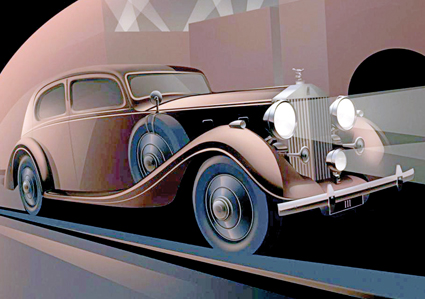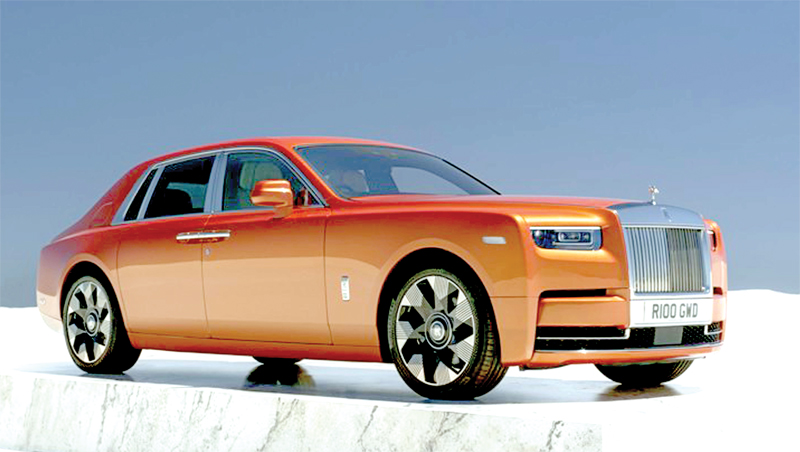At any given time during the past 100 years there has arguably been one car that has defined effortless luxury, and has remained the pinnacle of engineering excellence and highly skilled craftsmanship, and that is the Rolls-Royce Phantom.
The Rolls-Royce of Rolls-Royces, if you will, the Phantom has also played a rather large part in shaping the world around it, being used as a symbol of authority by world leaders, royalty and military commanders, and a symbol of success by celebrities and cultural icons over its eight generations.
To celebrate the centenary, Rolls-Royce has had its designers create a series of original artworks paying tribute to its cultural impact through the decades, with the company saying that the artworks “echo a historical precedent dating back to 1910”, when the artist Charles Sykes – who would later create the Spirit of Ecstasy mascot – was commissioned to produce six original oil paintings for the Phantom’s 80-page catalogue. The company says the artworks illustrate just how much its client profile has diversified over the past century, and has recounted the history of a number of iconic Phantom owners to drive that point home.
Royal service
 One of the great commanders of the Second World War, Field Marshal Bernard Law Montgomery, 1st Viscount Montgomery of Alamein, was commonly known as ‘Monty’, but he also picked up the nickname ‘the Spartan General’ for his austere lifestyle. However, Monty’s sole concession to comfort was in his personal transport; a pair of Phantoms. His day-to-day transport was a 1936 Phantom III with coachwork by Freestone & Webb. In the build-up to D-Day in June 1944, he used it to transport Winston Churchill, General Eisenhower and even King George VI to planning sessions at the Supreme Headquarters Allied Expeditionary Force in Southwick House, Hampshire.
One of the great commanders of the Second World War, Field Marshal Bernard Law Montgomery, 1st Viscount Montgomery of Alamein, was commonly known as ‘Monty’, but he also picked up the nickname ‘the Spartan General’ for his austere lifestyle. However, Monty’s sole concession to comfort was in his personal transport; a pair of Phantoms. His day-to-day transport was a 1936 Phantom III with coachwork by Freestone & Webb. In the build-up to D-Day in June 1944, he used it to transport Winston Churchill, General Eisenhower and even King George VI to planning sessions at the Supreme Headquarters Allied Expeditionary Force in Southwick House, Hampshire.
Montgomery also made use of the ‘Butler’ Phantom III, assigned to the Chief of the Imperial General Staff. So named because it was originally commissioned for Alan Samuel Butler, Chairman of the De Havilland Aircraft Company, its most distinctive feature was a front-sloping windscreen that made it 15 percent more aerodynamic.
Montgomery eventually bought the ‘Butler’ in 1958 and kept it until 1963, during which time it carried many passengers including the Prime Ministers of Canada, Australia and New Zealand. In 1948, the Duke of Edinburgh, newly married to Princess Elizabeth, paid a visit to Rolls-Royce and was loaned an experimental car with a newly designed straight-eight 5.3-litre engine nicknamed ‘the Scalded Cat’ by test drivers.
Not every Phantom was destined for royal service however, and some would come to symbolise an entirely different kind of cultural power – in December 1964, Britain’s “disruptor-in-chief”, John Lennon, rewarded himself for the success of The Beatles’ A Hard Day’s Night by commissioning a totally blacked-out Phantom V. The Phantom would also be a star of the silver screen in its own right, with the highlight coming in 1964 when it took a leading role in one of the year’s major movie releases – the third James Bond movie, Goldfinger, in which the eponymous villain uses his black-and-yellow 1937 Phantom III Sedanca de Ville to smuggle gold over the Furka Pass to his mountain lair. In recent years the Phantom has continued to be an aspirational touchpoint, experiencing a new wave of exposure via social media; the Phantom VII launched in 2003 at the very beginnings of what would eventually be called “social media” and quickly made an impact on the burgeoning platforms. It is, after all, a car to be seen in, and thanks to social media platforms like YouTube, Instagram and TikTok, the new wave of Phantom buyers could be – by millions of people around the world. (Driven)







